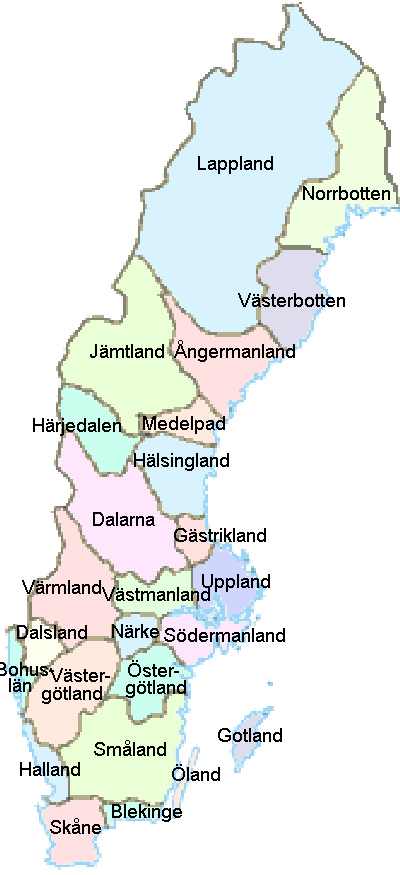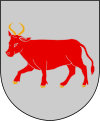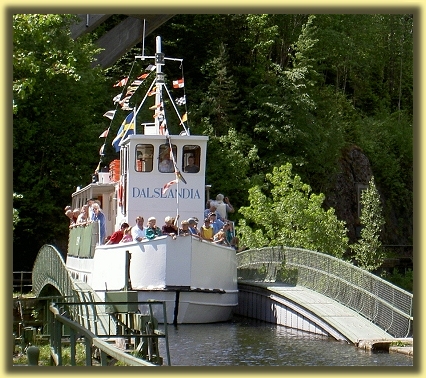Dalsland Geography
The Counties of Sweden
21 Counties of Sweden
and the City of Stockholm
|
 Counties of Sweden
Counties of Sweden
(län)
|
 Provinces of Sweden
Provinces of Sweden
(landskap)
|
25 Provinces of Sweden
|
The new County of Västra Götaland
49 kommune (municipalities)

On January 1, 1999, three counties of western Sweden merged to form the new county, Västra Götaland (Western Gothland). The counties were (1) Gothenburg and Bohus, (2) Skaraborg, and (3) Älvsborg. Prior to 1999, the land west of Lake Vänern was part of Älvsborg County. The new county has a population of 1.5 million, about 17% of the population of Sweden. It is the second largest county, in population, after Stockholm County. Västra Götaland consists of 49 kommune (municipalities), the largest being Göteborg, the capital and government seat.
Wikipedia Links: Ale | Alingsås | Bengtsfors | Bollebygd | Borås | Dals-Ed | Essunga | Falköping | Färgelanda | Grästorp | Gullspång | Götene | Göteborg | Herrljunga | Hjo | Härryda | Karlsborg | Kungälv | Lerum | Lidköping | Lilla Edet | Lysekil
| Mariestad
| Mark
| Mellerud
| Munkedal | Mölndal | Orust | Partille | Skara | Skövde | Sotenäs | Stenungsund | Strömstad | Svenljunga | Tanum | Tibro | Tidaholm | Tjörn | Tranemo | Trollhättan | Töreboda | Uddevalla | Ulricehamn | Vara | Vårgårda | Vänersborg | Åmål | Öckerö
Province of Dalsland
The towns mentioned in these biographies are all in the province (landskap) of Dalsland. The division of Sweden into provinces no longer has meaning other than historical. The Dalsland region is all contained within Västra Götaland County (län). Prior to 1999 Dalsland was in Älvsborg County.

Dalsland has a population of 50,000, about 3% of Västra Götaland County. It is a scenic rural area situated on the western side of Lake Vänern. Dalsland is called "Sweden's lake province." Most of Lake Vänern is in Västra Götaland County, the rest being in Värmland. It is the largest lake in Europe (excluding Russia), about 2,184 sq. mi. in area. The world's largest lake salmon (44 lb.) was caught in Lake Vänern.
The original name of Dalsland was Dal, used until the middle of the 19th century. Dal means "valley." Its coat of arms is a red bull. The arms was granted at the time of the funeral of Gustav Vasa [King of Sweden (1523-1560)]. The largest city in Dalsland is Åmål.
Province vs. County
Provincial names (landskap) are now archaic, but for centuries they defined the geography of Sweden. In 1634, Sweden adopted a new constitution and at that time switched to a county system (län) for regional administration. A Swedish county (län) is more like a U.S. state than a U.S. county. Sweden's counties are generally more important than its provinces.
Län - Härad - Socken
| Län |
Beginning in 1634, Dalsland took on the name, Älvsborg, under the new county system. This name continued in use until year-end 1998, when the area was redistricted into a larger area and renamed Västra Götaland. In the late 19th century the län name was sometimes spelled Elfsborg. |
| Härad |
Älvsborg is divided into five districts (Härad), each including a number of parishes: |
|
|
Nordal (east central):
Sundal (southeast):
Tössbo (northeast):
Vedbo (northwest):
Valbo (southwest): |
Holm, Skållerud, and more
Bolstad, Erikstad, Gestad, and more
Fröskog, Ånimskog, and more
|
| Socken |
The socken (parish) represents the area served by the local church. In a rural area this would typically include 50-100 farms, although most farms are actually a collection of several smaller farms. The parish is usually named for the largest village in its area. Today, the term församling is more commonly used for parish. |
Dalsland Canal

The Dalsland Canal begins at the Köpmannebro bridge north of Mellerud. It covers 160 miles and includes 31 locks. It connects a string of lakes and only about 6 miles can actually be considered canal. It was originally built in the 1860's to haul iron and wood products from Dalsland and Vårmland to the North Sea. It is no longer used commercially. Nowadays the canal serves as a tourist attraction.
Two passenger boats are available for trips on part of the canal. The M/S Dalslandia and M/S Storholmen each make daily trips between Håverud and Bengtsfor [map]. Return is available by train. Round trip is 360 Krona for the trip, five hours by boat and one hour by rail.
[Return to Genealogy Home Page]




